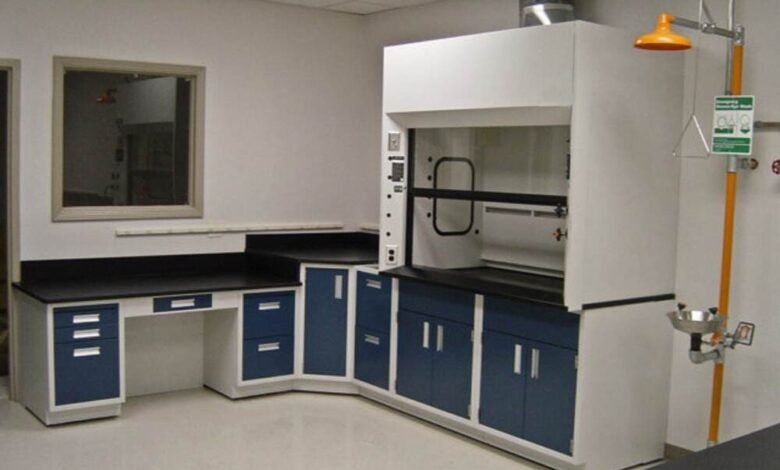
Improving Lab Safety and Durability with Stainless Steel Fume Hoods – In laboratory and hospital environments, safety and cleanliness are non-negotiable priorities. Protecting personnel from hazardous chemicals, maintaining sterility, and ensuring reliable equipment performance are essential in achieving safe and effective workspaces. One key piece of equipment that addresses these needs is the fume hood—specifically, stainless steel fume hoods, which offer unique advantages in terms of durability, safety, and ease of maintenance. In this article, we’ll explore how stainless steel fume hoods – lemari asam elevate lab safety, their advantages over other materials, and why they are an investment that pays off in the long run.
1. The Role of Fume Hoods in Lab Safety
Fume hoods are ventilation devices designed to limit exposure to harmful vapors, gases, and particles during laboratory procedures. They operate by drawing air away from the work area and filtering it through exhaust systems, helping to keep dangerous contaminants from accumulating in the lab or entering the respiratory pathways of staff.
In environments such as research facilities, pharmaceutical labs, and hospitals, where handling of volatile substances is common, fume hoods serve as essential barriers to protect both personnel and the environment. A high-quality, well-maintained fume hood can prevent accidents, reduce the spread of contaminants, and improve overall air quality, which is crucial for compliance with safety regulations and health standards.
2. Why Choose Stainless Steel for Fume Hoods?
While fume hoods are available in various materials, stainless steel fume hoods offer superior qualities in durability, resistance to corrosion, and ease of cleaning, making them an ideal choice for laboratories and hospitals. Here’s why stainless steel stands out:
Corrosion Resistance: Laboratories often deal with highly corrosive chemicals, which can degrade materials like plastic or painted steel over time. Stainless steel, with its high chromium content, resists corrosion, ensuring a longer lifespan even in harsh chemical environments.
Enhanced Cleanliness: Stainless steel’s non-porous surface makes it difficult for bacteria and other contaminants to adhere, allowing for easier and more effective cleaning. This is especially beneficial in hospital labs, where sterility is paramount.
Strength and Durability: Stainless steel fume hoods are highly durable, withstanding impact, heat, and daily wear and tear. This makes them an ideal investment for facilities that require equipment capable of handling rigorous use.
Aesthetic and Practical Appeal: The sleek, professional look of stainless steel also offers practical benefits. Unlike painted or coated surfaces, stainless steel doesn’t chip or peel, preserving a clean appearance without extra maintenance.
3. Key Benefits of Stainless Steel Fume Hoods in Laboratories and Hospitals
Improved Safety Standards
Stainless steel fume hoods contribute to improved safety by offering a secure barrier against chemical exposure. Their robust structure prevents leaks, reducing the risk of accidental inhalation or skin contact with hazardous substances. Moreover, stainless steel fume hoods are compatible with a wide range of chemicals, making them versatile and adaptable to different lab procedures.
Easy Maintenance and Hygiene
Hospitals and laboratories need equipment that is easy to clean and sanitize. Stainless steel’s resistance to both chemical corrosion and microbial growth simplifies cleaning protocols, allowing for regular disinfection without the risk of damage. For facilities that prioritize stringent hygiene, stainless steel fume hoods minimize the likelihood of cross-contamination.
Long-Term Cost Savings
While stainless steel fume hoods may have a higher upfront cost compared to alternatives, their durability and longevity result in lower maintenance and replacement costs over time. By choosing stainless steel, labs and hospitals can invest in equipment that will not only last longer but also require fewer repairs and downtime, making it a cost-effective choice.
4. Selecting the Right Stainless Steel Fume Hood for Your Facility
When selecting a stainless steel fume hood, it’s important to consider the specific needs of your laboratory or hospital environment. Key factors to evaluate include:
Size and Airflow Requirements: Ensure the hood fits within your space and provides the appropriate airflow for your laboratory’s requirements.
Filtration and Ventilation Capabilities: Depending on the type of chemicals used, you may need a hood with specialized filtration systems to handle specific substances.
Compliance with Industry Standards: Look for fume hoods that meet ANSI and OSHA standards to ensure safety and regulatory compliance.
Customization Options: Many suppliers offer customization for stainless steel fume hoods, allowing labs to tailor the equipment to their exact specifications, enhancing usability and functionality.
Conclusion: Investing in Safety with Stainless Steel Fume Hoods
For labs and hospitals focused on safety, cleanliness, and durability, stainless steel fume hoods are a top choice. Their unmatched resistance to corrosion, ease of maintenance, and long-term value make them indispensable for high-risk and high-precision environments. By investing in stainless steel fume hoods, facilities not only enhance their safety protocols but also reduce long-term maintenance costs, creating a safer, more reliable workspace for all.
In summary, as the demands on laboratory and hospital facilities grow, so too does the need for durable, efficient, and safe equipment. Stainless steel fume hoods meet these needs, making them a strategic choice for those prioritizing both short-term safety and long-term operational savings.



